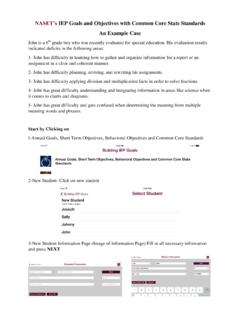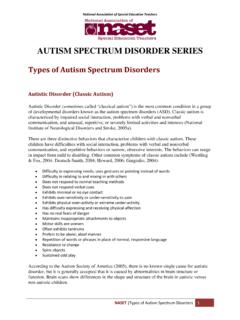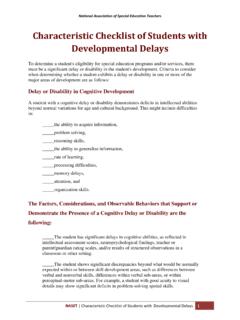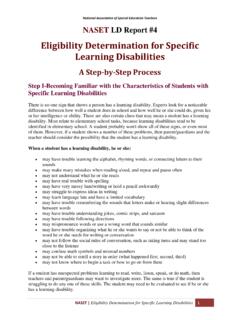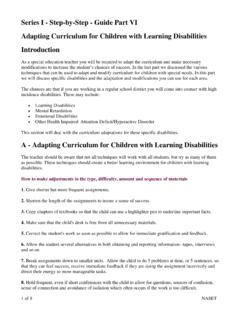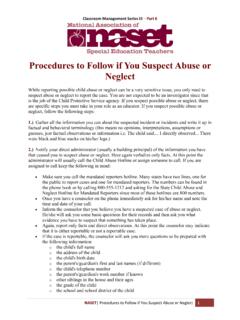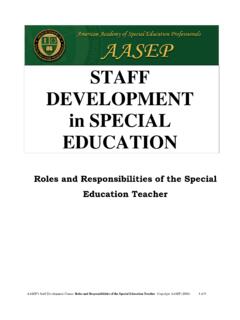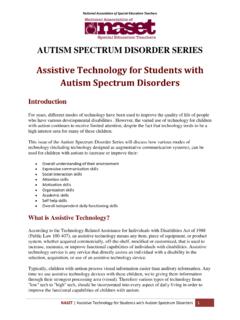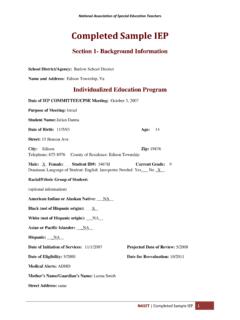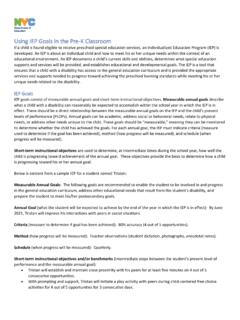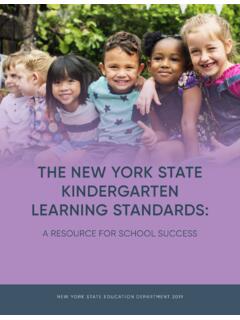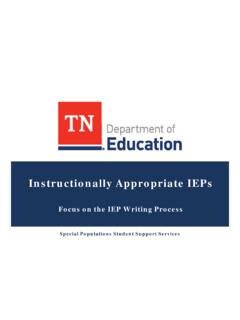Transcription of Examples IEP Goals Objectives for ASD - NASET
1 National Association of Special Education Teachers NASET | Examples of IEP Goals and Objectives Suggestions for Students with Autism 1 AUTISM SPECTRUM DISORDER SERIES Examples of IEP Goals and Objectives Suggestions for Students with Autism Introduction When writing Goals for children with Autism it is crucial to be as specific as possible. IEP s need to be individualized but do not always show all of the actual Goals and interventions that are being done. As a skill is acquired - new Objectives are to be added, it is not to be stagnant. As skills become easier the difficulty is increased. Teachers of students with Autism Spectrum Disorders hope that a fluid process from year to year is maintained.
2 This will require a great deal of communication and collaboration between staff and parents. The following lists are offered as Examples of IEP Goals that can be used for children with Autism Spectrum Disorders. Social Skill Area Goals 1. _____ will develop social understanding skills as measured by the benchmarks listed below. a. _____ will raise their hand and wait to be called on before talking aloud in group settings 4/5 opportunities to do so. b. _____will work cooperatively with peers in small group settings (ie. Share materials, allow peers to share different thoughts) 4/5 opportunities to do so. c. _____ will develop an understanding of the relationship between his/her verbalizations and actions/effect on others 4/5 opportunities to do so.
3 D. _____ will engage in appropriate cooperative social play interactions initiated by others 4/5 opportunities to do so. e. _____ will engage in cooperative social play interactions by allowing others to make changes or alter the play routine 4/5 opportunities to do so. f. _____ will engage in appropriate turn-taking skills by attending to peer s turn and waiting for own turn 4/5 opportunities to do so. g. _____will appropriately acknowledge an interaction initiated by others by giving an appropriate response, either verbal or non-verbal. h. _____ will develop an understanding of the rationale for various social skills by stating the reason when asked ( , Why do we say excuse me?) i.
4 _____ will increase social awareness of environment by stating what is taking place in environment or imitating actions of others 4/5 opportunities to do so. j. _____ will increase safety awareness by stating the effect of various situations 4/5 opportunities to do so. National Association of Special Education Teachers NASET | Examples of IEP Goals and Objectives Suggestions for Students with Autism 2 k. _____ will identify appropriate social rules and codes of conduct for various social situations 4/5 opportunities to do so. l. _____ will refrain from interrupting others by exhibiting appropriate social interaction skills 4/5 opportunities. 2. _____ will increase social-emotional skills as measured by the benchmarks listed below.
5 A. _____ will identify various emotional states in others 4/5 opportunities to do so. b. _____ will state why a person might be feeling a particular emotion 4/5 opportunities to do so. c. _____ will identify various simple emotional states in self 4/5 opportunities to do so. d. _____ will state why he/she might be feeling a particular emotion 4/5 opportunities to do so. e. _____ will state what would be an appropriate response to a particular emotional state 4/5 opportunities to do so. 3. _____ will increase social communication skills as measured by the benchmarks listed below. a. _____ will initiate communicative interactions with others 4/5 opportunities to do so. b. _____ will initiate varied appropriate topics with others 4/5 opportunities to do so.
6 C. _____ will initiate communicative interactions with others by asking questions 4/5 opportunities to do so. d. _____ will engage in conversational turn-taking with others across 3-4 conversational turns, 4/5 opportunities to do so (topics initiated by self /others). e. _____ will call attention to communicative partner prior to communicating 4/5 opportunities to do so. f. _____ will ask questions of others regarding topics initiated by self or others to sustain conversation for conversational turn-taking 4/5 opportunities to do so. g. _____ will identify and understand various non-verbal social communication behaviors (ie. Tone of voice, personal space, vocal volume, body orientation, facial expressions) by stating their implied meaning 4/5 opportunities to do so.
7 H. _____ will spontaneously seek assistance/ ask for help/ seek additional information given visual prompts 4/5 opportunities to do so. i. _____ will spontaneously use a verbal or non-verbal message to indicate to the speaker that he needs additional wait time to process information editorially 4/5 opportunities to do so. j. _____ will identify breakdowns in communication and make appropriate adjustments 4/5 opportunities to do so. 4. ____ will increase narrative discourse skills to objective criteria as measured by the benchmarks listed below. a. _____ will state the main idea of the story, video or situation 4/5 opportunities to do so. b. _____ will relate information (ie. Past events, stories, situations, ) sequentially 4/5 opportunities to do so.
8 C. _____ will identify what happened first, in the middle, and last regarding a previous read story, past event, or situation. d. When relating information_____ will provide an initial background statement, include referents, include important pieces of relational information and leave out irrelevant details. National Association of Special Education Teachers NASET | Examples of IEP Goals and Objectives Suggestions for Students with Autism 3 5. ____ will increase their ability to function appropriately within the school environment as measured by the benchmarks listed below. a. Given visual and verbal prompts, _____ will participate in tasks/ activities to completion by exhibiting appropriate behaviors, _% of the time.
9 B. _____ will transition appropriately from tasks and activities and school environments _% of the time given visual and verbal prompts. c. _____ will accept changes in routine/schedule by exhibiting appropriate behaviors given visual and verbal cues _ % of the time. d. _____ will follow classroom rules and directives given visual and verbal prompts _% of the time. e. _____ will independently take a break given visual prompts _ % of the time. (goal #5: Objectives contd.) f. _____ will independently ask to take a break given visual and verbal prompts _% of the time. Strategies to focus on above Goals / Objectives : Social Stories: Social Stories are a tool for teaching social skills to children with autism and related disabilities.
10 Social stories provide an individual with accurate information about those situations that he may find difficult or confusing. The situation is described in detail and focus is given to a few key points: the important social cues, the events and reactions the individual might expect to occur in the situation, the actions and reactions that might be expected of him, and why. The goal of the story is to increase the individual s understanding of, make him more comfortable in, and possibly suggest some appropriate responses for the situation in question (Polyxo, 2008). Comic Strip Conversations: Individuals with Autism Spectrum Disorder (ASD) have trouble interpreting social situations and understanding speech as quickly as most social interactions require.
